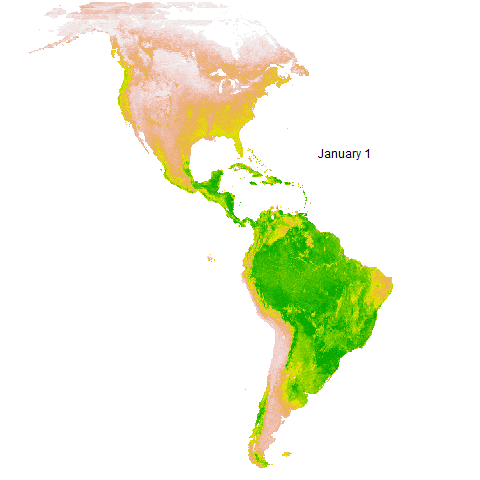A new study using sightings reported to eBird found that many migratory birds time movement to match “green-up” or emergence of leaves, as they travel north and south. Frank La Sorte, a research associate at the Cornell Lab of Ornithology and Catherine Graham, a researcher at the Swiss Federal Research Institute in Switzerland, found that migratory birds that eat plants and seeds moved north in sync with foliage emergence in the spring. This is the first study of its kind to examine migration timing in relation to seasonal changes in greenness for a large number of North American migratory bird species that feed on a variety of foods including plants, seeds, nectar, insects, birds, and small mammals. Their findings were published this week in the Journal of Animal Ecology.
La Sorte and Graham used data from satellites to estimate the greenness of vegetation year round and cross-referenced that data with observations submitted by eBirders for 230 North American migratory bird species from 2006 through 2018.
“As you might expect, migration synchronization with vegetation greenness is strongest for birds that eat vegetation, seeds, or both, during spring and autumn migration, but especially during spring,” says La Sorte, the lead author on the study. “You could say,” continues La Sorte, “that they follow the ‘green wave’ north in the spring and then follow it in reverse during the fall, keeping pace with a wave that is retreating ahead of the North American winter.”

The “green wave” of maturing and dying vegetation is plainly visible in this animation based on data from the MODIS imaging sensors onboard the Terra and Aqua satellites. Vegetation greenness in Central and South America remains relatively stable except in the eastern portion of the continent. Animation by Frank La Sorte, Cornell Lab of Ornithology.
But the association between timing of migration and greenness changed depending on what the bird ate and their migratory pathway (the eastern, central, or western flyways). The pattern, for example, did not hold for carnivorous birds, such as hawks and eagles, along the western flyway during spring or fall migration. These species primarily eat small mammals, whose abundance may not be associated with changes in the amount of greenness.
For birds that eat insects, La Sorte found a strong correlation between green-up and timing of migration when looking across all flyways, but when they examined insectivorous species along flyways separately, the strength of the relationship weakened, especially in the East. The reason for the lack of synchronization for insect-eating birds in the East, says La Sorte, is the ecological barrier to migration—the Gulf of Mexico. La Sorte suggests that birds wintering in Central and South America might not be able track vegetation changes on the U.S. side of the Gulf in spring and vice versa in the fall.
Understanding what factors affect timing of migration is important as changes in climate affect phenology or the timing of seasonal events. Vegetation green-up in the spring is controlled by changes in temperature and precipitation; die-back of vegetation in the autumn is controlled by temperature and hours of daylight—all factors that are important in timing of migrations.
“Our findings emphasize the need to better understand the environmental cues that regulate migratory behavior and the implications for migratory birds if these cues change,” La Sorte says. “Unchecked climate change means it‘s more likely that there will be a mismatch—migratory birds during stopover or when arriving on their breeding or wintering grounds could miss the peak food supply—no matter what they eat.”
eBirding throughout the year makes studies like this possible. Thank you for sharing your sightings!
Funding for this study comes from the Wolf Creek Charitable Foundation and the National Science Foundation.
Reference,
La Sorte, F. A., and C. H. Graham (2020). Phenological synchronization of seasonal bird migration with vegetation greenness across dietary guilds. Journal of Animal Ecology. https://doi.org/10.1111/1365-2656.13345



